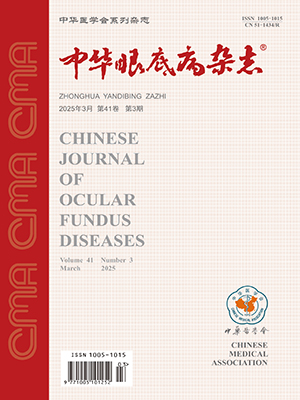| 1. |
Merrill J, Erkan D, Winakur J, et al. Emerging evidence of a COVID-19 thrombotic syndrome has treatment implications[J]. Nat Rev Rheumatol, 2020, 16(10): 581-589. DOI: 10.1038/s41584-020-0474-5.
|
| 2. |
Ali M, Spinler S. COVID-19 and thrombosis: from bench to bedside[J]. Trends Cardiovasc Med, 2021, 31(3): 143-160. DOI: 10.1016/j.tcm.2020.12.004.
|
| 3. |
Mir T, Almas T, Kaur J, et al. Coronavirus disease 2019 (COVID-19): multisystem review of pathophysiology[J/OL]. Ann Med Surg (Lond), 2021, 69: 102745[2021-08-23]. https://pubmed.ncbi.nlm.nih.gov/34457265/. DOI: 10.1016/j.amsu.2021.102745.
|
| 4. |
Sharma A, Parachuri N, Kumar N, et al. Myths and truths of the association of retinal vascular occlusion with COVID-19[J]. Retina, 2022, 42(3): 413-416. DOI: 10.1097/iae.0000000000003371.
|
| 5. |
Shiroma H, Lima L, Shiroma Y, et al. Retinal vascular occlusion in patients with the Covid-19 virus[J]. Int J Retina Vitreous, 2022, 8(1): 45. DOI: 10.1186/s40942-022-00371-7.
|
| 6. |
Invernizzi A, Pellegrini M, Messenio D, et al. Impending central retinal vein occlusion in a patient with coronavirus disease 2019 (COVID-19)[J]. Ocul Immunol Inflamm, 2020, 28(8): 1290-1292. DOI: 10.1080/09273948.2020.1807023.
|
| 7. |
Rego Lorca D, Rouco Fernandez A, Jimenez Santos M, et al. Bilateral retinal vein occlusion and diabetic retinopathy after COVID-19[J/OL]. Acta Ophthalmol, 2021, 99(7): e1246-e1248[2020-12-23]. https://pubmed.ncbi.nlm.nih.gov/33354904/. DOI: 10.1111/aos.14718.
|
| 8. |
Walinjkar J, Makhija S, Sharma H, et al. Central retinal vein occlusion with COVID-19 infection as the presumptive etiology[J]. Indian J Ophthalmol, 2020, 68(11): 2572-2574. DOI: 10.4103/ijo.IJO_2575_20.
|
| 9. |
Lee MY, Bae ON, Chung SM, et al. Enhancement of platelet aggregation and thrombus formation by arsenic in drinking water: a contributing factor to cardiovascular disease[J]. Toxicol Appl Pharmacol, 2002, 179(2): 83-88. DOI: 10.1006/taap.2001.9356.
|
| 10. |
Okoroh E, Hooper W, Atrash H, et al. Is polycystic ovary syndrome another risk factor for venous thromboembolism? United States, 2003-2008[J]. Am J Obstet Gynecol, 2012, 207(5): 377. DOI: 10.1016/j.ajog.2012.08.007.
|
| 11. |
Finn A, Khurana R, Chang L. Hemi-retinal vein occlusion in a young patient with COVID-19[J/OL]. Am J Ophthalmol Case Rep, 2021, 22: 101046[2021-04-05]. https://pubmed.ncbi.nlm.nih.gov/33688598/. DOI: 10.1016/j.ajoc.2021.101046.
|
| 12. |
Venkatesh R, Reddy N, Agrawal S, et al. COVID-19-associated central retinal vein occlusion treated with oral aspirin[J/OL]. BMJ Case Rep, 2021, 14(5): e242987[2021-05-19]. https://pubmed.ncbi.nlm.nih.gov/34011649/. DOI: 10.1136/bcr-2021-242987.
|
| 13. |
Raval N, Djougarian A, Lin J. Central retinal vein occlusion in the setting of COVID-19 infection[J]. J Ophthalmic Inflamm Infect, 2021, 11(1): 10. DOI: 10.1186/s12348-021-00241-7.
|
| 14. |
Power GM, Sanderson E, Pagoni P, et al. Methodological approaches, challenges, and opportunities in the application of Mendelian randomisation to lifecourse epidemiology: a systematic literature review[J]. Eur J Epidemiol, 2024, 39(5): 501-520. DOI: 10.1007/s10654-023-01032-1.
|
| 15. |
Boehm FJ, Zhou X. Statistical methods for Mendelian randomization in genome-wide association studies: a review[J]. Comput Struct Biotechnol J, 2022, 20: 2338-2351. DOI: 10.1016/j.csbj.2022.05.015.
|
| 16. |
Burgess S, Scott RA, Timpson NJ, et al. Using published data in mendelian randomization: a blueprint for efficient identification of causal risk factors[J]. Eur J Epidemiol, 2015, 30(7): 543-552. DOI: 10.1007/s10654-015-0011-z.
|
| 17. |
Skrivankova VW, Richmond RC, Woolf BAR, et al. Strengthening the reporting of observational studies in epidemiology using mendelian randomization: the STROBE-MR Statement[J]. JAMA, 2021, 326(16): 1614-1621. DOI: 10.1001/jama.2021.18236.
|
| 18. |
Kurki MI, Karjalainen J, Palta P, et al. FinnGen provides genetic insights from a well-phenotyped isolated population[J]. Nature, 2023, 613(7944): 508-518. DOI: 10.1038/s41586-022-05473-8.
|
| 19. |
Palmer T, Lawlor D, Harbord R, et al. Using multiple genetic variants as instrumental variables for modifiable risk factors[J]. Stat Methods Med Res, 2012, 21(3): 223-242. DOI: 10.1177/0962280210394459.
|
| 20. |
Burgess S, Dudbridge F, Thompson S. Combining information on multiple instrumental variables in Mendelian randomization: comparison of allele score and summarized data methods[J]. Stat Med, 2016, 35(11): 1880-1906. DOI: 10.1002/sim.6835.
|
| 21. |
Bowden J, Smith GD, Burgess S. Mendelian randomization with invalid instruments: effect estimation and bias detection through Egger regression[J]. Int J Epidemiol, 2015, 44(2): 512-525. DOI: 10.1093/ije/dyv080.
|
| 22. |
Bowden J, Smith GD, Haycock PC, et al. Consistent estimation in mendelian randomization with some invalid instruments using a weighted median estimator[J]. Genet Epidemiol, 2016, 40(4): 304-314. DOI: 10.1002/gepi.21965.
|
| 23. |
Hemani G, Zhengn J, Elsworth B, et al. The Mr-Base platform supports systematic causal inference across the human phenome[J/OL]. Elife, 2018, 7: e34408[2018-05-30]. https://pubmed.ncbi.nlm.nih.gov/29846171/. DOI: 10.7554/eLife.34408.
|
| 24. |
Bowden J, Del Greco MF, Minelli C, et al. Improving the accuracy of two-sample summary-data Mendelian randomization: moving beyond the NOME assumption[J]. Int J Epidemiol, 2019, 48(3): 728-742. DOI: 10.1093/ije/dyy258.
|
| 25. |
Verbanck M, Chen C, Neale B, et al. Detection of widespread horizontal pleiotropy in causal relationships inferred from Mendelian randomization between complex traits and diseases[J]. Nat Genet, 2018, 50(5): 693-698. DOI: 10.1038/s41588-018-0099-7.
|
| 26. |
Heidarzadeh HR, Abrishami M, Shariati MM, et al. Atypical central retinal artery occlusion following COVID-19 infection: a case report[J]. Case Rep Ophthalmol, 2023, 14(1): 405-410. DOI: 10.1159/000532108.
|
| 27. |
Sunny CLA, Callie KLK. Prevalence of SARS-CoV-2 among central retinal artery occlusion patients: a case series-HORA study report No. 3[J]. J Acute Dis, 2021, 10(4): 147-149. DOI: 10.4103/2221-6189.318644.
|
| 28. |
Ashkenazy N, Patel NA, Sridhar J, et al. Hemi- and central retinal vein occlusion associated with COVID-19 infection in young patients without known risk factors[J]. Ophthalmol Retina, 2022, 6(6): 520-530. DOI: 10.1016/j.oret.2022.02.004.
|
| 29. |
Al-Moujahed A, Boucher N, Fernando R, et al. Incidence of retinal artery and vein occlusions during the COVID-19 pandemic[J]. Ophthalmic Surg Lasers Imaging Retina, 2022, 53(1): 22-30. DOI: 10.3928/23258160-20211209-01.
|
| 30. |
Modjtahedi BS, Do D, Luong T, et al. Changes in the incidence of retinal vascular occlusions after COVID-19 diagnosis[J]. JAMA Ophthalmol, 2022, 140(5): 523-537. DOI: 10.1001/jamaophthalmol.2022.0632.
|




